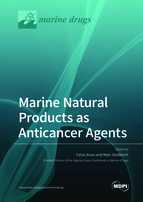Marine Natural Products as Anticancer Agents
A special issue of Marine Drugs (ISSN 1660-3397).
Deadline for manuscript submissions: closed (15 June 2021) | Viewed by 33718
Special Issue Editors
Interests: marine natural products; biotechnological applications; pharmaceutical applications; signal transduction; anticancer activities; compounds isolation
Special Issues, Collections and Topics in MDPI journals
Interests: oncology; signal transduction; cell death; inflammation
Special Issues, Collections and Topics in MDPI journals
Special Issue Information
Dear Colleagues,
Despite the advances concerning cancer biology and its therapeutic strategies achieved in the last decades, cancer remains a huge threat for human health, and one of the deadliest diseases worldwide. One of the main factors contributing to the high cancer mortality is related to therapy failure and consequent cancer relapse; thus it is of the utmost importance to develop innovative therapeutics strategies, including new drugs. In this field, marine natural products have revealed uncommon and rare chemical features, not found in the terrestrial environment, on which the molecular modelling and chemical synthesis of novel anticancer drugs can be inspired. As these compounds were produced in co-evolution with biological systems, they present greater an efficiency and specificity for interacting with biological target sites, exhibiting novel mechanisms of action and the ability to modulate distinct intracellular signaling pathways.
The focus of this Special Issue will be to highlight the potential of marine natural products as anticancer agents, empathizing the diversity of the molecular targets and the mechanistic effects. The application of innovative scientific approaches, including co-cultures and 3D culture models, to avoid the gap between in vitro and in vivo experiments is encouraged. Approaches describing synergistic combination treatments of marine compounds with clinically-used or experimental anticancer agents are welcome.
As compounds with anticancer immune modulatory functions are well-known, publications describing the cancer activity of such marine compounds alone or in combination with checkpoint inhibitors are encouraged to be submitted.
For this Special Issue, we invite academic and industry scientists to submit reviews and original and conceptual research articles highlighting the biological activities of known or novel marine compounds with a potential anticancer activity.
Dr. Celso Alves
Prof. Dr. Marc Diederich
Guest Editors
Manuscript Submission Information
Manuscripts should be submitted online at www.mdpi.com by registering and logging in to this website. Once you are registered, click here to go to the submission form. Manuscripts can be submitted until the deadline. All submissions that pass pre-check are peer-reviewed. Accepted papers will be published continuously in the journal (as soon as accepted) and will be listed together on the special issue website. Research articles, review articles as well as short communications are invited. For planned papers, a title and short abstract (about 100 words) can be sent to the Editorial Office for announcement on this website.
Submitted manuscripts should not have been published previously, nor be under consideration for publication elsewhere (except conference proceedings papers). All manuscripts are thoroughly refereed through a single-blind peer-review process. A guide for authors and other relevant information for submission of manuscripts is available on the Instructions for Authors page. Marine Drugs is an international peer-reviewed open access monthly journal published by MDPI.
Please visit the Instructions for Authors page before submitting a manuscript. The Article Processing Charge (APC) for publication in this open access journal is 2900 CHF (Swiss Francs). Submitted papers should be well formatted and use good English. Authors may use MDPI's English editing service prior to publication or during author revisions.
Keywords
- anticancer
- anti-tumor
- immune
- molecular targets
- co-cultures
- 3D culture models
- marine natural products








